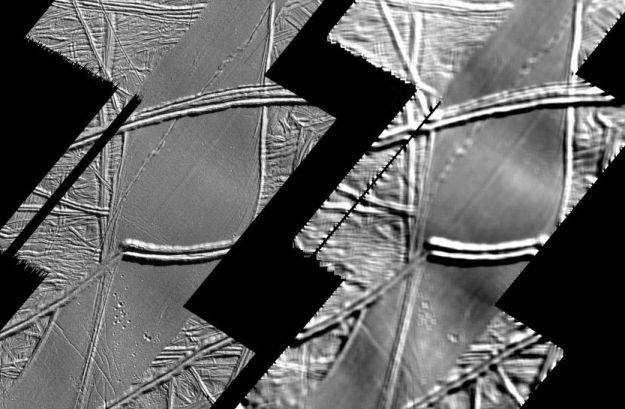Credit & Copyright: L. M. Prockter (JHU APL),
R. T. Pappalardo (Brown University),
JPL,
Galileo Project,
NASA
Explanation:
Astypalaea
Linea on
Jovian
ice moon
Europa is the broad smooth
region running through
these images recorded by the Galileo
spacecraft in 1998.
The pictures are different computer processed versions of the
same mosaic -- on the left, small scale details have been enhanced
while on the right, large scale features are emphasized.
In both versions, the bold
criss-crossing ridges believed
to result from the upwelling of new material through cracks in the surface
ice are apparent.
But more easily seen on the right are
recently recognized
gentle rises and dips, about 15 kilometers across, which likely formed
as the icy surface was compressed by the addition of
the new material.
Further
evidence that stress is folding
Europa's surface
is offered by the presence of smaller cracks and wrinkles more
easily seen on the left.
These span the width of the broad swells suggestive of
anticlines and synclines familiar to geologists
on planet Earth.
Though
ice covered, the surface of Europa is thought
to be geologically active, riding over a
substantial
ocean of liquid water.
1999 2000 2001 2002 2003 2004 2005 2006 2007 2008 2009 2010 2011 2012 2013 2014 2015 2016 2017 2018 2019 2020 2021 2022 2023 2024 2025 |
Январь Февраль Март Апрель Май Июнь Июль Август Сентябрь Октябрь Ноябрь Декабрь |
NASA Web Site Statements, Warnings, and Disclaimers
NASA Official: Jay Norris. Specific rights apply.
A service of: LHEA at NASA / GSFC
& Michigan Tech. U.
|
Публикации с ключевыми словами:
кольца - Jupiter - Moon - Europa - Сатурн
Публикации со словами: кольца - Jupiter - Moon - Europa - Сатурн | |
См. также:
Все публикации на ту же тему >> | |
